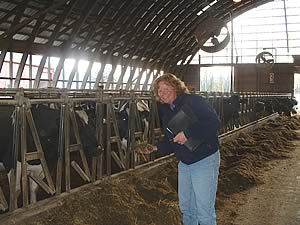 |
|||||||||
|
|||||||||||||||||||
Strike
the right dietary balance to avoid SARA
Regular snacking and plenty of time on the couch may not be a healthy lifestyle for humans but, according to US consultant Mary Beth de Ondarza, it is the way for dairy cows to maintain optimum health and productivity. Speaking at a farmer meeting in Cumbria organised jointly by Massey Brothers and Alltech, the dairy nutrition specialist from New York State highlighted a host of practical measures that help to identify and resolve often unseen and costly digestive upsets. She focused specifically on the increasingly common problem of sub-acute rumen acidosis (SARA), covering relatively new ideas such as daily time budgeting, cow comfort, feed presentation and the use of yeast culture, in what was an invigorating presentation. Running her own successful dairy nutrition consultancy in the north of New York State and Vermont, Dr de Ondarza is well used to working with dairy farmers that are feeding very similar diets to UK units, and who are under similar - if not more extreme - economic pressures. "Dairy farmers in my homeland have been operating with low and fluctuating milk prices for many years and, as a result, they have had to maintain the highest levels of management to survive," she pointed out. "Dealing with issues such as SARA is a day-to-day challenge, with the key being to identify potential problems early and take the most appropriate action." Tell tale signs of SARA identified by Dr de Ondarza included daily fluctuations in intake and milk production, reduced cudding, and a reluctance to come into the parlour. It may not necessarily only occur in herds that are feeding high levels of concentrates. "Cows can be giving 35kg/day, but could still be suffering from SARA," she said. "In these cases the cows may be capable of giving an additional 2-3kg/day if the problem is resolved, but you have to identify it first. "One of the best ways to spot SARA is to make regular observations of the dung. If there are inconsistencies day-to-day, with bubbles and pastiness occurring as well as some with dung with a stiffer consistency, then you may well have cows with a problem. The goal is to have every pile of manure look like a pile of shaving cream!" The challenge is always to strike the right balance in the diet to maximise production whilst maintaining a healthy rumen. Providing the right level of effective fibre is the key to balancing the high energy feeds, with the optimum level being determined by many variables, including both the digestibility of the fibre and the sources of starch and sugar used for energy. "There are no hard and fast rules, but it is generally important to keep the non-fibre carbohydrate below 40% of the total dry matter of the ration in order to avoid problems like SARA," said Dr de Ondarza. "The optimum level of effective fibre required depends on the general make up of the ration, and specifically factors such as the length of fibre and the method of feeding. Fibre must be long enough to chew, with approximately 15% of the ration being made up of particles longer than 1.5 inches." Preventative rationing is common in the US, with bicarbonate used routinely as a buffer, and live yeast culture (such as Yea-Sacc1026) included to help stabilise rumen pH and improve fibre digestion. It is also common practice to include 1 - 1.5 kg of hay or 0.25 - 0.5 kg of straw, typically chopped to 2 - 3 inches. Rationing aside, there are also many practical points that Mary Beth de Ondarza believes are key to maintaining optimum rumen function. These include adopting a management regime that avoids "slug feeding" and allows cows sufficient time to eat, ruminate and rest in any 24-hour period. "The daily time budget for milking cows should allow 18 - 20 hours for resting and ruminating and 3 - 5 hours for eating and drinking," she revealed. "Cows in an environment that is 30% overcrowded will ruminate 25% less, and an extra hour of rest in a day will result in an extra kilogram of milk due to better health and blood flow to the udder. The importance of the se cow comfort factors cannot be over-emphasised in my view." The management routine and building layout should encourage frequent feeding, as this helps to maintain a stable rumen pH and increase overall intake, and the feed should be mixed and presented in such a way as to avoid sorting. "If you can see holes in the feed as it lies in the trough it shows that cows are sorting, and that means you no longer have a total mixed ration," said Dr de Ondarza. "Keeping the ration below 45% dry matter - by adding water to the ration rather than ensiling wet forages - will help to reduce sorting. You should expect to have around 5% of the feed left at the end of the feeding period in order to be sure intakes are not being restricted. This should be cleaned up and ideally fed to non-milking stock, or possibly recycled to low lactation cows."
|
|||||||||||||||||||

|
|
||||||||||||||||||
| home | agri-services | pedigree
pen | news | dairy | beef | machinery BPS | property | organisations | site map |
|||||||||||||||||||
